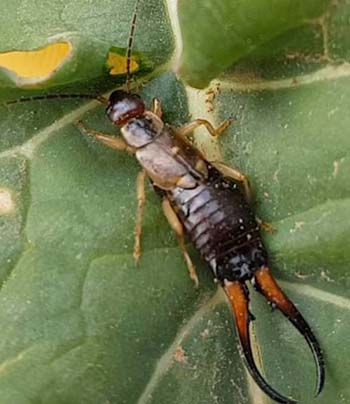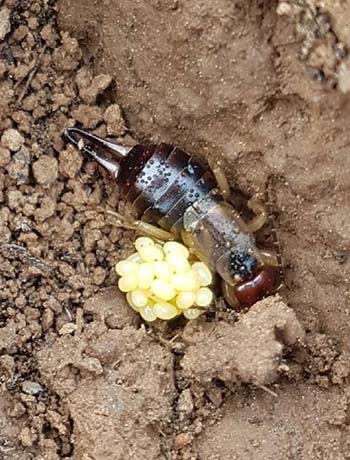Pest profile
European earwig - an appetite for destruction
- Gangs of juveniles mainly damage crops
- Juveniles feed at night throughout winter and spring
- Seedlings are vulnerable, particularly canola
- Eggs hatch during the breeding season from May to October
- Between 30 and 80 youngsters inhabit a single nest
- A brood of youngsters can destroy five young canola plants near their nest
- Disturbing topsoil can reveal nests.
They emerge under the cover of darkness - gangs of youths causing damage to grain crops on farms across the country.
Investigating the trail of in-crop destruction left by these tiny vandals is a GRDC investment looking at the pest ecology of earwigs, particularly the invasive European species (Forficula auricularia), in Australian grains operations.
Leading the research from 2016 to 2018, CSIRO postdoctoral research fellow Matthew Binns says the study, to date, shows earwig crop damage is predominantly caused by gangs of juvenile European earwigs.
This pattern of crop damage is the finding of Dr Binns' study at the CSIRO Ginninderra Experiment Station, near Canberra, ACT, this year.
His research shows the destructive cohorts emerge from their communal, underground nests in paddocks to feed on plant leaves, particularly in mild, dry weather conditions, for several hours after sunset throughout winter and spring. He says the resulting damage is cumulative, with immature European earwigs feeding on young plants near their nests for a few hours each night while they develop into adults over six months from late May or early June to November.
Dr Binns says a single brood of 30 to 80 youngsters, which hatch from eggs during the breeding season from May to October, are likely to destroy about five young canola plants in the vicinity of their nest.
In contrast, adult earwigs tend to roam crops at night, causing "small amounts of sporadic damage, except in situations where the stems are targeted, which can lead to significant damage", he says.
"There is potential for crop damage throughout the entire year, but it is of greatest concern when crops are at the vulnerable seedling stage, and juvenile earwigs are also developing."
Dr Binns says another earlier laboratory study examined earwig feeding preferences in canola, chickpeas, lentils, lucerne, lupins, oats and wheat.
"The study found canola was the most vulnerable crop to European earwig damage. Whereas earwigs are unlikely to cause major damage in wheat and oats," he says.
Applying this new knowledge to pest management, Dr Binns urges growers to monitor paddocks for earwig nests after sowing, particularly following rain, from April to July.
He recommends growers dig within 30 centimetres of damaged plants since young earwigs are unlikely to travel far from the nest to feed.
 Crop damage is predominantly caused by gangs of juvenile European earwigs. PHOTO Matthew Binns, CSIRO
Crop damage is predominantly caused by gangs of juvenile European earwigs. PHOTO Matthew Binns, CSIRO
Disturbing the topsoil can reveal the nests, which females usually excavate no deeper than five centimetres in the soil under rocks, stubble or soil clods.
"Placing tiles or similar shelter traps on the soil surface just after sowing can help gauge the density of nests within paddocks," he says, adding that nest distribution is generally scattered across paddocks, but they can occur in damaging clusters.
"Widespread crop damage can result from high nest density over large areas, so estimating the number of nests in a given area is important for determining the need for control measures."
Monitoring is also important in helping to inform approaches to pest control because crop damage caused by earwigs can be difficult to distinguish from the damage caused by slugs, snails, slaters and millipedes.
Dr Binns says earwig identification is another important component of pest management because native earwig species may have a beneficial ecological role in farming systems.
Earwig ecology
For example, the native earwig species Labidura truncata, which is larger than its European counterpart and has a distinctive triangle on its back, provides crop benefits as a predator of insect pests.
However, the native species Nala lividipes, which is smaller than the European earwig and darker in colour, is considered a pest in Queensland, but its pest status remains unclear in southern Australian grains operations.
Helping to fill this knowledge gap, GRDC investment until 2020 aims to better understand the ecology, particularly the pest status, of the three dominant native species of earwig found in grain crops.
 European earwigs usually excavate nests in which they lay eggs no deeper than five centimetres in the soil under rocks, stubble or soil clods. Photo: Matthew Binns
European earwigs usually excavate nests in which they lay eggs no deeper than five centimetres in the soil under rocks, stubble or soil clods. Photo: Matthew Binns
These were among 10 species collected as part of surveys by researchers from the Western Australian Department of Primary Industries and Regional Development, New South Wales Department of Primary Industries, South Australian Research and Development Institute and the University of Melbourne.
The European earwig has become established in most of its habitat niche across south-eastern Australia since it was introduced to this country 170 years ago.
However, it has only gained a foothold in Western Australia in the past 24 years, meaning it has the potential to spread into the state's northern growing areas.
"Earwigs have become an increasingly damaging pest in southern Australian winter grain crops during the past decade, which contrasts with their beneficial status in orchards in Australia and around the world," Dr Binns says.
He says European earwigs are unlikely to cause major overall losses to crop biomass at low densities of less than five nests per ten square metres.
More information: Matthew Binns, 0428 466 610, matthew.binns@csiro.au; European earwig identification and life cycle video.

























































